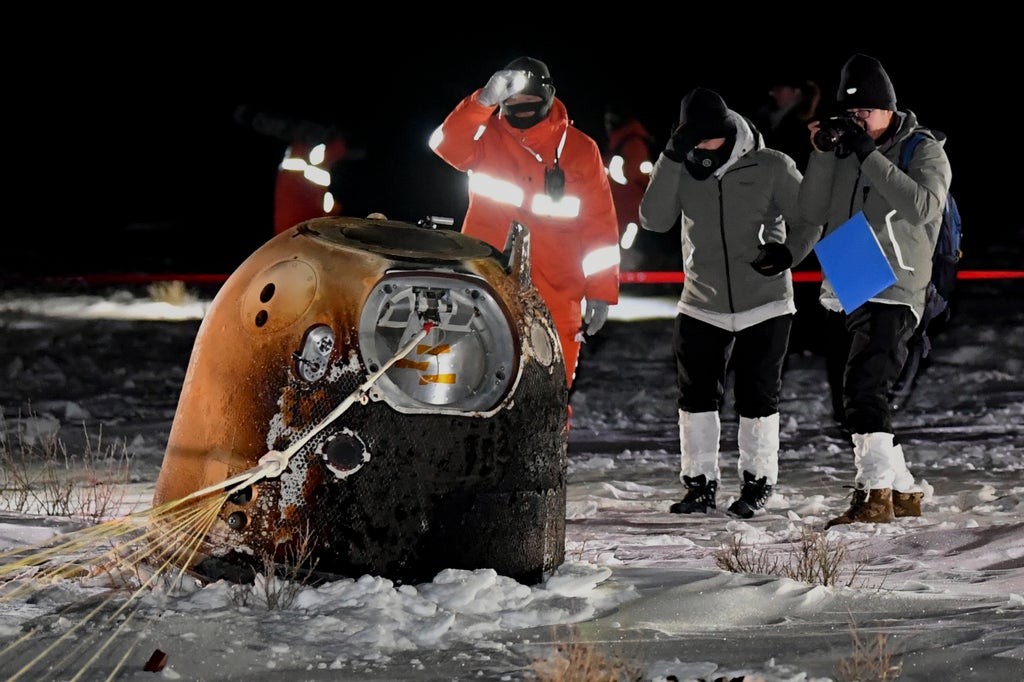
Planetary scientists may soon have a better yardstick for measuring the evolution of the Moon, following a new study that fills in gaps in the record of meteor impacts on the Moon.
A team of Chinese scientists used data from Chang’e-5 lander, China’s first lunar sample return mission, to fill in gaps in the lunar geologic record and update the chronological models scientists use to study the Moon’s evolution that previously relied on Apollo and other 1970s era sample missions. The study was published Monday in a letter in the journal Nature Astronomy.
While the new models do not dramatically change scientists’ understanding of the Moon, they will help researchers to more precisely date lunar events. And because the impact chronology of the Moon has been extrapolated to other bodies in the Solar System, “these results have important implications for the chronology and impact history of the inner Solar System,” the study authors write in the letter.
Existing lunar chronology models, such as the Neukem model, show a steep, exponential decrease in the rate of impacts resulting in craters of 1 kilometre in diameter on the Moon prior to 3 billion years ago, and a nearly steady rate of such impacts after that time.
But with the new Chang’e-5 data, the researchers’ model shows a slightly higher rate of impacts from around 3.1 To 3.9 billion years ago. The new model and older models are nearly identical from 3.1-billion-years ago until today, and the biggest differences are no greater than 1.2 billion years. Overall, it suggests older ages for most impacts than previously believed, without changing the overall picture of the Moon’s history.
“The updated model confirms the general pattern of the Neukum model and improves the dating precision, particularly in the period of the gap in lunar samples,” said Kaichang Di, a scientist focusing on remote sensing and mapping at the Chinese Academy of Sciences and lead author of the letter.
Existing models of lunar impact chronology are primarily based on the samples taken by Nasa’s Apollo missions and the Luna missions of the former Soviet Union. Chang’e-5, which landed on the Moon on 1 December, 2020, and returned samples to Earth on 16 December, 2020, was the first sample return mission to the Moon since Luna 24 in 1976.
Although immensely helpful to lunar scientists, the Apollo and Luna samples did not contain any material dating from about 1 billion to 3 billion years ago, leaving a gap of almost half the Moon’s history in the lunar chronology models.
Chang'e-5 landed in the Moon’s Northern Oceanus Procellarum, an area of the Moon characterized by younger volcanic activity and thus rocks and regolith dating to around 2 billion years ago, right in the temporal gap in Apollo and Luna samples. Using a drill and scooping mechanism, Chang’e-5 collected almost two kilograms of material to return to Earth for analysis at the Institute of Geology and Geophysics of the Chinese Academy of Sciences.
The new findings will not cause a paradigm shift but are more akin to developing a more precise ruler for measuring the dates of episodes in the Moon’s evolution, and that of other planetary bodies.
“As the chronology models of other rocky bodies were extended from the lunar chronology model by consideration of the differences in their impacting rate, impact velocity, gravity, etc,” Dr. Kaichang said, “The updated lunar chronology model, if extended to other bodies using the same principles previously used, will result in the same effect as for the Moon — i.e., same pattern but slightly older ages.”
China will launch another sample return mission to the Moon, Chang’e-6, sometime in 2024, and is currently exploring the far side of the Moon with the Yutu-2 rover. The Chinese lunar exploration program ultimately calls for the construction of a permanent research station at the Moon’s South pole sometime in the 2030s.







